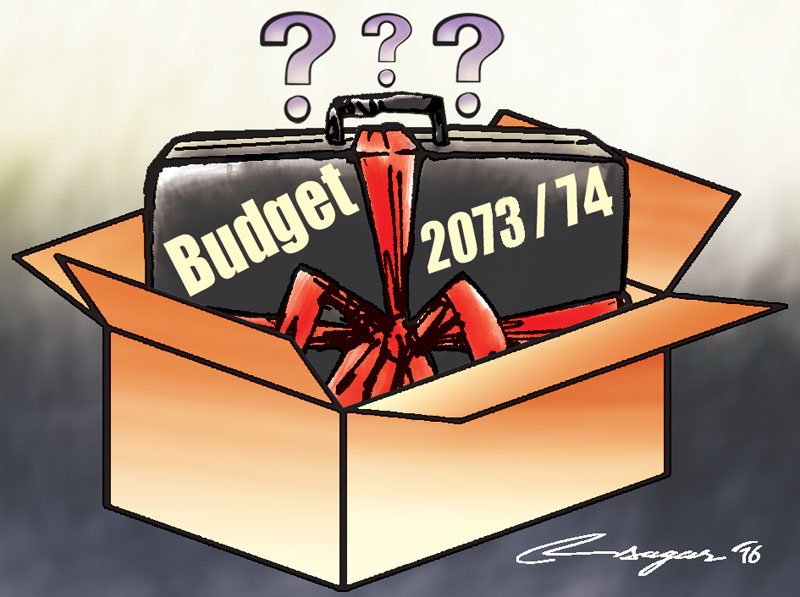Budget for next fiscal: Stumbling blocks and options
Added by expanded social security related programs to the vulnerable including informal labor market workers, massive skill oriented youth employment should be the focus of the budget
Unlike conventionally, the coming fiscal year budget has larger obligations. The budget has to prove through built in structure and directions coupled with policies and programs that it has followed the path set by the constitution. Unlike top downs, it will require a trickling up approach as per federal principles. As an offshoot, it will need embedding of equity, inclusiveness and self reliant development led prosperity principles more robustly. Needles to add, there are many economic and social rights as well as social security related commitments in the constitution.
Moreover, the sustainable development goals (SDGs) additionally require more broad and comprehensive strategic, policy and program directions in the budget at the same time bringing coherency with the constitution for assuring that Nepal has both vision and capacity to meet the SDGs by 2030. There is also a need to clarify whether Nepal will be able to fulfill the promises of graduating from the Least Developed category to a developing one by 2022 amidst bigger downside risk.
The most prioritized and pressing objectives of the coming budget has to be on two fronts. One, the budget has to state more candidly how rehabilitation and reconstruction works will be expedited ahead in a war footing way by removing various barriers which have led to implementation failures in critical fronts this fiscal year. Second, the budget has to give higher priority to revive the economy. This may need special policy and program packages and directions. Similarly, more robust ways and means to control black marketing and skyrocketing prices are essential. These are prerequisites to create favorable bases of the promised long term goals.
Paradoxically, however, the stumbling blocks rooted in institutional, structural, policy and governance related fronts are deeper and challenging. Although some of them perpetuated in systemic ways are covered in the constitution, they are yet to be made operational through new rules, regulations and governance mechanism. Not only are the federal and local government structures lacking but also such a possibility in the near future is uncertain. Notwithstanding some rooms for stopgap arrangements in these areas, invasive problems in the economic spheres are again dreadful.
First, the composition and pattern of government budget is such that almost 90 per cent consists of current expenses. Of the total budget outlay, almost similar share is allocated to the so called number one priority projects. As a top down process, a practice of budget tying with fiscal balance criteria is leading to the undermining of deeper intra and inter sectoral structural issues linking with the overall and micro management of the budget taking performances, efficiency and timely outcomes into account. There is a custom of continuing or holding of the same resource drain projects since decades leading to jeopardizing of development efforts including serious energy and infrastructure shortages or bottlenecks, among others. Over concentration of resources in limited accessible areas and exclusionary practices is deeply rooted in the budgetary system. Predominated by ad hoc pull and push practices, there is no system in place which could guide the budget at least in an ex-ante way to ensure consistency among macro, sectoral and micro policy and program proposals and probable outcomes.
Second, along with adverse business and investment environment fuelled by institutional, policy and coordination led failures, private sector resource flows coming mostly from external transfers are overflowed to the non-tradable or unproductive areas leading to aggravation of both supply and demand side related structural problems simultaneously. The monetary policy practices are facilitating that discourse. As offshoots, there is mushrooming of parallel economy partly induced by tax policies, obstructive bureaucratic behavior and very high transaction cost embedded largely in the governance system.
Although minimizing such systemic or structural problems drastically through a single budget is impossible, being a first post constitution budget it should be path breaking through major reform initiatives in such critical areas. Grounded on this, a shift in paradigm, priorities and future directions should be there to be compatible with the above mentioned promises again with topmost priority on reconstruction and revival of the economy, including ensuring of reliefs to the common people. With major trust on self reliant development discourse led higher growth trajectory backed by massive expansion in private sector driven investment in production and infrastructure sectors, equity and inclusive dimension should get a subsequent priority both vertically and spatially focusing on deprived people and backward areas.
Added by expanded social security related programs to the vulnerable including informal labor market workers, massive skill enhanced led youth employment should be the focus of the budget. The cooperative movement should be conceived as an important vehicle of self-help development from the grass roots. Above all, the budget must reverse the eroded credibility with concrete steps and measures to ensure implementation effectively for better delivery and outcomes.






